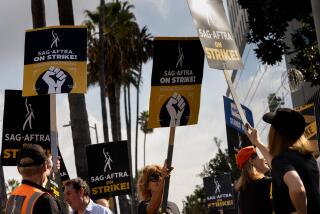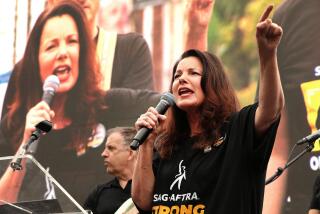On Labor Day, 1938, toward the end...
- Share via
On Labor Day, 1938, toward the end of the Great Depression, 90,000 workers marched north on Broadway, singing their way toward City Hall.
Thirty bands blared music and African-American musicians were “swinging it . . . madly,” a Times reporter wrote.
More than 200 unions were represented in the march. An actor dressed as Abraham Lincoln proclaimed that all racial groups deserved the fruits of labor, and people dressed as Popeye and the Keystone Kops pretended to chase away scabs. A float advertising Savings Bonds was decorated with a gigantic hand holding an eight-foot certificate.
A few Labor Days later, in 1941, the country was on the verge of war. Workers were putting in long hours at defense plants, and most traditional union celebrations in downtown Los Angeles were canceled.
In 1946, when the war was over, more than 150,000 unionists marched down Broadway.
But by the late 1940s, the labor unions had largely given up downtown marches in favor of picnics with pole-climbing races and baseball games, contests of strength and speed, boxing matches and bicycle and mule races. Unionized printers held typesetting contests.
Union officials had all but stopped broadcasting their customary radio addresses on Labor Day, and industries and employees had begun to move to the suburbs.
By 1950, things were far different from when Los Angeles held its first Labor Day parade in 1895, with horse-drawn floats on which craftsmen demonstrated their trades.
Over the years, organized labor has taken some lumps and has notched some victories.
These days, the meaning of the annual celebration of the pride and dignity of the American worker is sometimes overlooked. For many, Labor Day has become just another three-day weekend--the last holiday of summer.
More to Read
The biggest entertainment stories
Get our big stories about Hollywood, film, television, music, arts, culture and more right in your inbox as soon as they publish.
You may occasionally receive promotional content from the Los Angeles Times.










